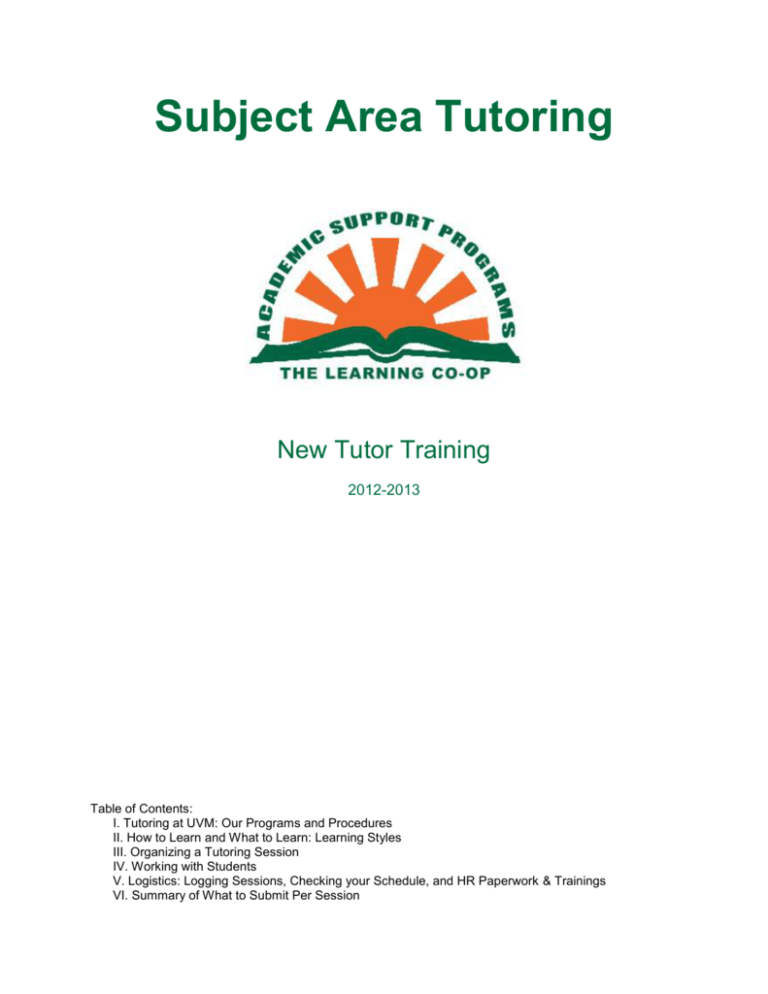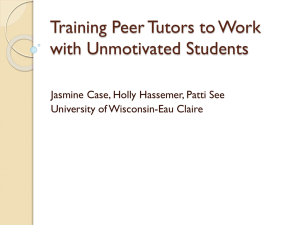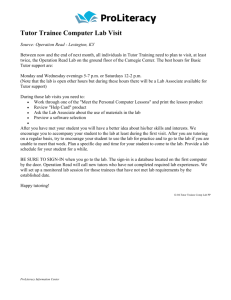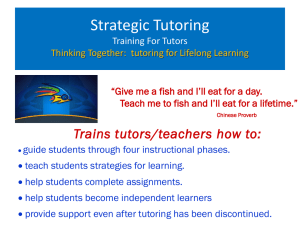
Subject Area Tutoring
New Tutor Training
2012-2013
Table of Contents:
I. Tutoring at UVM: Our Programs and Procedures
II. How to Learn and What to Learn: Learning Styles
III. Organizing a Tutoring Session
IV. Working with Students
V. Logistics: Logging Sessions, Checking your Schedule, and HR Paperwork & Trainings
VI. Summary of What to Submit Per Session
I. Tutoring at UVM
Wait, what did she say?
What are the different ways a student can get help in Subject-Area Tutoring?
What is the difference between Campus-Wide and Co-op based appointments?
How often can a student meet with a tutor?
2
Our Expectations:
What can students expect of their tutors?
1. Respect.
2. That tutors will maintain the highest privacy standards in terms of protecting personal
information in relation to those whom they tutor.
3. That tutors will respond to email and/or phone calls within a reasonable amount of time
(within 24 hours).
4. That tutors are committed to acting in the tutees’ best interest, this includes never doing
the tutees’ work. Tutors are not to work on graded homework assignments without the
professor’s permission.
5. That tutors will practice and promote accuracy, honesty, and truthfulness.
6. That tutors will exercise reasonable judgment and take precautions to ensure that their
potential biases, the boundaries of their competence, and the limitations of their
expertise do not lead to or condone unjust practices.
What should tutors expect of students?
1. That you will come prepared to your tutoring session, this includes bringing your book
and graded assignments, as well as attempted homework assignments and specific
questions.
2. That all cancellations will be made to the tutor via email or phone well before the tutoring
session. In this scenario, it is the student’s responsibility to reschedule. Please note
that you may be charged for all appointments that you do not attend and do not cancel
24 hours in advance.
3. That you will respect the predetermined appointment duration, and respectfully
renegotiate if necessary.
4. That you will come into the session understanding that the tutor will neither do the work
for you nor assume the role already occupied by the course instructor or teaching
assistant.
What can both tutors and students expect of each other?
1. Mutual respect for cultural, individual, and role differences, including those based on
age, sex, gender identity, race, ethnicity, culture, national origin, religion, sexual
orientation, disability, language, and socioeconomic status.
2. Tutors will arrive on time and be prepared for your tutoring session. In the case of tutor
cancellation, he/she will email to reschedule. On the same note, students will also be on
time and prepared. If the student needs to cancel, he or she must notify the tutor at
least 24 hours in advance and make the effort to reschedule.
3. Maintenance of a professional and mature discourse during the session.
3
Learning Styles Survey
For each item, circle the number that best describes you, with 6 being most and 0 being least true.
1. I prefer tasks requiring the operation, construction, or manipulation of
objects or materials over ones requiring reading or writing.
2. I seek an organized structure, want lessons to be clearly spelled out in
step-by-step order, and want to know the teacher’s expectations.
3. I keep a sharp focus on technical information and enjoy complex ideas.
4. I learn best in face-to-face dialogue and enjoy discussing the content of
lessons with a small group of peers.
5. I focus on the immediate, am not interested in the past and future, and do
not like to plan or prepare.
6. I place high value on good study habits, enjoy completing workbooks, and
like practice and drill.
7. I like to experiment and invent, and enjoy analyzing and solving complex
problems.
8. I am satisfied with an overall grasp of learning and am not good at
mastering details or searching for facts.
9. I like competitive interactions more than cooperative ones and am more
responsive to instructional games than lectures or discussions.
10. I have difficulty grasping abstractions and do best when learning the
practical aspects of a subject.
11. I display a stronger desire to be capable and gain intelligence than to
have freedom to act, social belonging, or meaningful relationships.
12. I am interested in and seem to have superior insight into what people
think, feel, or want.
13. I respond to class work only when I find it to be fun and entertaining, and
become inattentive if it requires study and concentration.
14. I tend to be sensible, stable, and practical rather than imaginative,
creative, or ingenious.
15. I have a preference for long-term independent projects, which I can carry
out with little teacher help.
16. I enjoy the communication process and have a talent for expressing my
feelings and thoughts.
0123456
0123456
0123456
0123456
0123456
0123456
0123456
0123456
0123456
0123456
0123456
0123456
0123456
0123456
0123456
0123456
Enter your rating (0-6) in the following space for each item (1-16). Total each column. The highest
total represents your preferred learning style.
SPONTANEOUS
ORGANIZED
CONCEPTUAL
INTERACTIVE
1.
2.
3.
4.
5.
6.
7.
8.
9.
10.
11.
12.
13.
14.
15.
16.
TOTAL:
TOTAL:
TOTAL:
TOTAL:
4
II. How to Learn and What to Learn
Learning StylesTutoring a student is more than giving them the answer to a problem; it is a careful art of blending the
mastery of subject-material with the methods of accumulating such knowledge. It is the integration of
how to learn with what to learn. But not every student will learn the same way. Helping a student to be
successful in a class requires patience and an understanding of how they learn best.
The following description of Learning Styles and accompanying Learning Styles quiz has been borrowed
from the text Learning and Motivation Strategies for Achievement, page seven (Tuckman, Bruce W.,
Dennis A. Abry, and Dennis R. Smith. Learning and Motivation Strategies: Your Guide to Success. Upper
Saddle River, NJ: Pearson/Prentice Hall, 2008. Print.).
“People learn in at least four different ways. One way is spontaneous. This means learning from the
experience of actually doing something, without it necessarily being in a teaching-learning situation. You
may have learned to ride a bike this way, by just hopping on and pushing the pedals as quickly as you
could. You may have fallen off a few times, but soon you got the hang of it.
Spontaneous learning is physical learning, which means it requires hands-on manipulation and actual
performance. The motivation for spontaneous learning comes from the excitement of it, often brought on
by competition, risk, adventure, and the enjoyment of performance. Spontaneous learners, that is, people
who prefer to learn this way, like action and the freedom to act, and tend to be easily distracted when in
passive learning situations, like a typical classroom.
The second way is organized. Organized learning, and the student who prefers it, require structure,
sequence, and advance notice. A good syllabus and clear requirements are musts. Great opportunity for
practice, frequent assignments, and clear grading criteria are equally important. Repetition and
explanation are preferred.
The third way to learn is conceptual. Conceptual learners require the opportunity to work independently,
to pose questions and seek answers, to collect and classify data, to solve complex problems, and to try to
understand, explain, and predict what they encounter.
The fourth way is interactive. Interactive learners require the opportunity for interaction and
communication with other people. They prefer subjects that deal with people and call for a personal
focus, rather than more technical or detail-oriented ones. They have much less interest in detail than on
larger meaning. The like to create, to speculate, write, and interpret.”
5
So What?
After taking the Learning Styles test and determining your Learning Style, re-read the descriptions
of each style above. Which characteristics do you most identify with, and which don’t seem to fit?
Think back to a class that was particularly difficult for you. How might your preferred Learning
Style have contributed to the difficulty or your dislike of the course?
How might you benefit from elements of each of the Learning Styles?
As a college student, it is up to you (and your students) to adapt your study methods for
a course to your own Learning Style preferences. You may be a spontaneous learner
stuck in a 300-person lecture or your tutee could be a conceptual learner in a rigidly
structured recitation. It is up to you as a student and as a tutor to recognize your
strengths and preferences and to create a study plan that allows you to be successful in
any situation.
For example, consider how effective each of the following activities would be for your learning
style: keeping logs or journals, participating in small group discussions, doing math problems with
a group of friends, making a group sculpture, listening to teacher directions, writing papers, going
on a walk around campus, studying for a unit test, or another type of academic work?
How could you address a student’s Learning Style in a session? What would you do to create an
ideal learning environment, and how could you teach them to implement these methods during
their individual study time?
6
III. Organizing a Tutoring Session
The following chapter from the book Becoming an Effective Tutor (Myers, Lynda B. "Lesson
Three: Coaching Tutees to Win." Becoming an Effective Tutor. Los Altos, CA: Crisp
Publications, 1990. Print. p7-10.) outlines a solid strategy for approaching the organization
of a tutoring session.
7
Take a moment to digest…
What sort of questions could you ask to assess a student’s level of comfort with certain class
material?
Taking an assessment at the beginning of the session is closely linked to setting goals for your time
with the student. A good goal will be challenging, yet attainable, and clearly defined. List a few good
goals for a tutoring session.
How could you incorporate your knowledge of different Learning Styles into your methods for
demonstrating course materials and study techniques during a session?
8
Practice makes perfect.
Especially for problem-based courses (math, chemistry, etc) it is of the utmost importance that
students practice the skills and concepts you have worked on together. This means actually
doing problems without the help of the tutor. What are some ways you can incorporate practice
into your sessions?
9
Positive Thinking.
There are multiple ways to give positive feedback and encouragement to students. Positive verbal
reinforcement, such as the comments “good,” “fine,” and “excellent” allow a tutor to immediately indicate
satisfaction with a students response. These are most effective when varied and used intermittently. Positive
nonverbal reinforcement, like a nod or smile, is also reassuring to a student. This also includes maintaining a
posture that displays respect and interest, maintaining eye contact, and facing a student. Qualified
reinforcement allows the tutor to reinforce separate parts of a response, drawing attention to the positive aspect
of a response while guiding the student to amend incorrect thinking. Finally, delayed reinforcement allows the
tutor to hearken back to a student’s earlier success and build upon these skills or concepts.
Now list a few examples of effective feedback and positive messages you can send students during a
session:
10
One step further…
How do the concepts outlined in the Learning Pyramid reflect the strategies we discussed for
organizing a session?
11
IV. Working with Students
“Effective helpers trust that others have the necessary human
resources to discover and implement solutions to their problems, and
act as guides along the path of exploration, understanding, and problem
resolution.”
-(Ender, Steven C., and Fred B. Newton. Students Helping Students: a Guide for Peer
Educators on College Campuses. San Francisco: Jossey-Bass, 2000. Print. p 85.)
“Respect is the belief in the capacity of the people seeking help to
help themselves and can usually be demonstrated by good
attending behavior, refraining from doing anything for people that
they could do themselves, and supporting people in their efforts.”
- Ender, Steven C., and Fred B. Newton. Students Helping Students: a Guide for
Peer Educators on College Campuses. San Francisco: Jossey-Bass, 2000. Print.
A Safe Space.
It’s not always easy to ask for help. While it may seem like idle chatter, taking the time to get to
know your student at the start of a session is worth every minute. Use this space to brainstorm
ways you can make your tutoring session more welcoming and encouraging for your student:
12
Helpful Hints for Tutoring English Language Learners
Below are some quick-tips to assist you when working with English Language Learners:
1. Create an atmosphere where the student feels accepted
The more comfortable a student feels with the tutor, the less anxious he or
she will feel about speaking, making mistakes, and learning.
Focus on the positive and introduce the student to his or her surroundings
(for example, show the student a tour around the Co-op)
2. Do not assume that the student has been introduced to the American style of
writing
You may need to cover the structure of an academic paper
3. Prioritize the session
There may be a lot of questions or material to get to in a short period of
time. If necessary, address the major issues first and set up an additional
appointment if necessary.
Setting goals may be appropriate so that the student also has an agenda
and knows what to expect from the session.
4. ELL students are most likely to make errors with articles
This is a particular issue for Asian or Russian students, whose languages
do not use articles.
The basic rule is: countable nouns require articles and uncountable nouns
generally do not. Using a concrete noun requires a definite article, but
reference to an abstract noun usually requires an indefinite article.
However, problems arise because some article use is idiomatic.
5. Don’t “fix” it
Explain to the student WHY a change is being made in his or her work
rather than just fixing it without explanation
If you can’t find an explanation for an error, particularly a grammar mistake
in writing, don’t lie.
6. Don’t dominate the session
Often, ELL will be shy to speak, ask questions, or interrupt. Asking questions,
engaging the student, and challenging the student will enable the ELL to
improve his or her English, receive assistance in the class, and make the
session a two-way street.
7. When tutoring math, be aware of cultural differences
Decimal and comma usage varies by culture
The U.S. measurement system is different than the rest of the world’s
8. Check your speed
Ask your student if your speed of talking is okay. This will ensure that the
student can understand you. If an ELL student does not understand you, he
or she may be afraid to ask you to slow down.
13
V. Logistics
Sexual Harassment Training: HR will get in touch. Must provide a certificate of completion.
Faculty Recommendation:
Before you can begin working in the Co-op, you will need to request a faculty recommendation
for each course you wish to tutor. To obtain the necessary faculty recommendation to work as a
Subject-Area Tutor in the Learning Co-op, or to add a new class to the list of courses you can
tutor, send the following link to your Professor for the course. A survey will appear when it is
opened and, upon completion, the finished recommendation will be automatically sent to the
Learning Co-op. http://www.uvm.edu/~learnco/sat/facrec/
If you or your professors have any difficulty with completing the recommendation, please
contact Keith Williams, Tutor Program Coordinator (656-7964/Keith.M.Williams@uvm.edu).
Weekly updates, important links, and instructions for logging sessions and entering
hours can all be found on the subject-area tutoring blog:
http://blog.uvm.edu/subtutor/
What to Submit for each type of appointment:
Campus-Wide Appointments:
1. Create a “Quick Visit” in TutorTrac to create a record of the session. Be sure to fill in all
of the fields.
2. Enter the hours you have worked into PeopleSoft. Be sure they match the date and
number of sessions you have reported in TutorTrac.
Co-op Based Appointments:
1. Be sure to check your schedule on TutorTrac no more than an hour before your
scheduled availability.
2. When you meet with a student, return to your schedule to mark the session as attended
and to complete your notes in the session record.
3. Enter the hours you have worked into PeopleSoft. Be sure they match the date and
number of sessions you have reported in TutorTrac.
Drop-In Group Tutors and SI Leaders:
1. You will need to have all students sign an attendance sheet for each session you have.
We will log the sessions into TutorTrac here in the Learning Co-op; you do not need to
do this.
2. You will need to submit a work summary report before the end of each pay period.
3. Enter the hours you have worked into PeopleSoft. Be sure they match the date and
number of sessions you have reported in TutorTrac and on your work summary report.
Work-Study Tutors:
1. Follow the directions as indicated above.
2. For Co-op based appointments, remember you are required to show up and get paid for
all availabilities, even if no one schedules an appointment with you.
3. You will need to complete a paper work summary report (found by the printer and on the
blog) each week and submit it to Keith.
14
4. You will need to enter your hours into PeopleSoft weekly.
15





